Steel Fiber Use as Shear Reinforcement on I-Shaped UHP-FRC Beams
Abstract
:1. Introduction
2. Experimental Program
2.1. Material Properties and Mixture Design
2.2. Details of Beam Specimens and Test Setup
3. Test Results and Observations
3.1. Material Test Results
3.2. Structural Test Results
3.2.1. Cracking Behavior and Failure Modes
3.2.2. Deflection Ductility
3.2.3. Curvature Ductility
3.2.4. Load Carrying Capacity
4. Numerical Predictions of the Shear and Flexural Capacities
4.1. Predicting the Nominal Shear Capacity
4.2. Predicting of the Flexural Moment Capacity
5. Conclusions
Author Contributions
Funding
Conflicts of Interest
References
- Fehling, E.; Schmidt, M.; Walraven, J.; Leutbecher, T.; Frönlich, S. Ultra-High Performance Concrete UHPC: Fundamentals, Design, Examples, Beton-Kalender; Wilhelm Ernst & Sohn: Berlin, Germany, 2014. [Google Scholar]
- AFGC/SETRA. Recommendation: Ultra High Performance Fibre-Reinforced Concretes, Revised ed.; Association Française de Génie Civil, Service D’études Techniques Des Routes et Autoroutes; AFGC Publication: Paris, France, 2013. [Google Scholar]
- JSCE. Recommendations for Design and Construction of Ultra-High Strength Fiber Reinforced Concrete Structures; JSCE Guidelines for Concrete No. 9; Japan Society of Civil Engineers: Tokyo, Japan, 2006. [Google Scholar]
- JSCE. Recommendations for Design and Construction of High Performance Fiber Reinforced Cement Composites with Multiple Fine Cracks (HPFRCC); Concrete Engineering Series 82; Japan Society of Civil Engineers: Tokyo, Japan, 2008. [Google Scholar]
- Russell, H.G.; Graybeal, B.A. Ultra-High Performance Concrete: A State-of-the-Art Report for the Bridge Community; HWA-HRT-13-060, U.S.; Federal Highway Administration: McLean, VA, USA, 2013.
- Habel, K.; Gauvreau, P. Response of ultra-high performance fiber reinforced concrete (UHPFRC) to impact and static loading. Cem. Concr. Compos. 2008, 30, 938–946. [Google Scholar] [CrossRef]
- Wille, K.; Naaman, A.E.; Parra-Montesinos, G.J. Ultra-high performance concrete with compressive strength exceeding 150 MPa (22 ksi): A simpler way. ACI Mater. J. 2011, 108, 46–54. [Google Scholar]
- Wille, K.; Naaman, A.E.; El-Tawil, S.; Parra-Montesinos, G.J. Ultra-high performance concrete and fiber reinforced concrete: Achieving strength and ductility without heat curing. Mater. Struct. 2012, 45, 309–324. [Google Scholar] [CrossRef]
- Wille, K.; Parra-Montesinos, G.J. Effect of beam size, casting method, and support conditions on flexural behavior of ultra-high-performance fiber-reinforced concrete. ACI Mater. J. 2012, 379–388. [Google Scholar]
- Hussein, L.; Amleh, L. Size effect of ultra-high performance fiber reinforced concrete composite beams in shear. Struct. Concr. 2018, 19, 141–151. [Google Scholar] [CrossRef]
- Park, J.J.; Kang, S.T.; Koh, K.T.; Kim, S.W. Influence of the Ingredients on the Compressive Strength of UHPC as A Fundamental Study to Optimize the Mixing Proportion. In Proceedings of the Second International Symposium on Ultra High Performance Concrete, Kassel, Germany, 5–7 March 2008; pp. 105–112. [Google Scholar]
- Yoo, D.Y.; Lee, J.H.; Yoon, Y.S. Effect of fiber content on mechanical and fracture properties of ultra high performance fiber reinforced cementitious composites. Compos. Struct. 2013, 106, 742–753. [Google Scholar] [CrossRef]
- Kim, D.J.; Park, S.H.; Ryu, G.S.; Koh, K.T. Comparative flexural behavior of hybrid ultra high performance fiber reinforced concrete with different macro fibers. Constr. Build. Mater. 2011, 25, 4144–4155. [Google Scholar] [CrossRef]
- Turker, K.; Hasgul, U.; Birol, T.; Yavas, A.; Yazici, H. Hybrid fiber use on flexural behavior of ultra high performance fiber reinforced concrete beams. Compos. Struct. 2019, 229, 111400. [Google Scholar] [CrossRef]
- Hasgul, U.; Turker, K.; Birol, T.; Yavas, A. Flexural behavior of ultra-high-performance fiber reinforced concrete beams with low and high reinforcement ratios. Struct. Concr. 2018, 19, 1577–1590. [Google Scholar] [CrossRef]
- Turker, K.; Birol, T.; Yavas, A.; Hasgul, U.; Yazici, H. Flexural behavior of beams with ultra high performance fiber reinforced concrete. Tech. J. 2019, 30, 8777–8801. [Google Scholar]
- Yavas, A.; Hasgul, U.; Turker, K.; Birol, T. Effective fiber type investigation on the shear behavior of ultrahigh-performance fiber-reinforced concrete beams. Adv. Struct. Eng. 2019, 22, 1591–1605. [Google Scholar] [CrossRef]
- Baby, F.; Marchand, P.; Toutlemonde, F. Shear behavior of ultrahigh performance fiber-reinforced concrete beams. I: Experimental investigation. J. Struct. Eng. 2014, 140, 04013112. [Google Scholar] [CrossRef]
- El-Dieb, A.S.; El-Maaddawy, T.A.; Al-Rawashdah, O. Shear Behavior of Ultra-High-Strength Steel Fiber Reinforced Self-Compacting Concrete Beams. In Proceedings of the First International Conference on Construction Materials and Structures, Johannesburg, South Africa, 24–26 November 2014; pp. 972–979. [Google Scholar]
- Tahenni, T.; Chemrouk, M.; Lecompte, T. Effect of steel fibers on the shear behavior of high strength concrete beams. Constr. Build. Mater. 2016, 105, 14–28. [Google Scholar] [CrossRef]
- Qi, J.-N.; Ma, Z.J.; Wang, J.-Q.; Liu, T.-X. Post-cracking shear strength and deformability of HSS-UHPFRC beams. Struct. Concr. 2016, 17, 1033–1046. [Google Scholar] [CrossRef]
- Kim, C.-G.; Lee, H.; Park, H.-G.; Hong, G.-H.; Kang, S.-M. Effect of steel fibers on minimum shear reinforcement of high-strength concrete beams. ACI Struct. J. 2017, 114, 1109–1119. [Google Scholar] [CrossRef]
- Pourbaba, M.; Joghataie, A. Shear behavior of ultra-high performance concrete. Constr. Build. Mater. 2018, 183, 554–564. [Google Scholar] [CrossRef]
- Mészöly, T.; Randl, N. Shear behavior of fiber-reinforced ultra-high performance concrete beams. Eng. Struct. 2018, 168, 119–127. [Google Scholar] [CrossRef]
- Yoo, D.Y.; Yang, J.M. Effects of stirrup, steel fiber, and beam size on shear behavior of high strength concrete beams. Cem. Concr. Compos. 2018, 87, 137–148. [Google Scholar] [CrossRef]
- Zhao, J.; Liang, J.; Chu, L.; Shen, F. Experimental study on shear behavior of steel fiber reinforced concrete beams with high-strength reinforcement. Materials 2018, 11, 1682. [Google Scholar] [CrossRef] [Green Version]
- Ciprian, T.; Dan, B.; Victor, V.; Cornelia, M. Ultra high performance fiber reinforced concrete I beams subjected to shear action. ACTA Tech. Napoc. Civ. Eng. Archit. 2012, 55, 121–126. [Google Scholar]
- Voo, Y.L.; Poon, W.K.; Foster, S.J. Shear strength of steel fiber-reinforced ultra high-performance concrete beams without stirrups. J. Struct. Eng. 2010, 136, 1393–1400. [Google Scholar] [CrossRef]
- Kamal, M.M.; Safan, M.A.; Etman, Z.A.; Salama, R.A. Behavior and strength of beams cast with ultra high strength concrete containing different types of fibers. HBRC J. 2014, 10, 55–63. [Google Scholar] [CrossRef] [Green Version]
- Zagon, R.; Matthys, S.; Kiss, Z. Shear behaviour of SFR-UHPC I-shaped beams. Constr. Build. Mater. 2006, 124, 258–268. [Google Scholar] [CrossRef]
- Lim, W.Y.; Hong, S.G. Shear tests for ultra-high performance fiber reinforced concrete (UHPFRC) beams with shear reinforcement. Int. J. Concr. Struct. M. 2016, 10, 177–188. [Google Scholar] [CrossRef] [Green Version]
- Ngo, T.T.; Park, J.K.; Pyo, S.; Kim, D.J. Shear resistance of ultra-high-performance fiber-reinforced concrete. Constr. Build. Mater. 2017, 151, 246–257. [Google Scholar] [CrossRef]
- Hegger, J.; Bertram, G. Shear Carrying Capacity of Ultra-High Performance Concrete Beams. Tailor Made Concrete Structures; Walraven, J.C., Stoelhorst, D., Eds.; Taylor & Francis Group: London, UK, 2008; pp. 341–347. [Google Scholar]
- Yang, I.H.; Kim, B.S.; Joh, C. Shear behaviour of ultra-high performance fibre-reinforced concrete beams without stirrups. Mag. Concr. Res. 2012, 64, 979–993. [Google Scholar] [CrossRef]
- Model Code 2010. Fib Model Code for Concrete Structures 2010; International Federation for Structural Concrete; Wilhelm Ernst & Sohn: Berlin, Germany, 2013. [Google Scholar]
- ACI 318. Building Code Requirements for Structural Concrete (ACI 318M-14) and Commentary (318R-14); American Concrete Institute: Farmington Hills, MI, USA, 2014. [Google Scholar]
- Yoo, D.-Y.; Yuan, T.; Yang, J.M.; Yoon, Y.S. Feasibility of replacing minimum shear reinforcement with steel fibers for sustainable high-strength concrete beams. Eng. Struct. 2017, 147, 207–222. [Google Scholar] [CrossRef]
- TS-500. Requirements for Design and Construction of Reinforced Concrete Structures; Turkish Standards Institution: Ankara, Turkey, 2000. [Google Scholar]
- EN 1992-1-1. Eurocode 2: Design of Concrete Structures—Part 1–1: General Rules and Rules for Buildings; European Committee for Standardization: Brussels, Belgium, 2004. [Google Scholar]
- Park, R. Evaluation of ductility of structures and structural assemblages from laboratory testing. Bull. N. Z. Natl. Soc. Earthqu. Eng. 1989, 22, 155–166. [Google Scholar]
- NZS 3101. Concrete Structures Standard—Part 1: The Design of Concrete Structures; The Earthquake Commission (EQC) and Department of Building and Housing (DBH): Wellington, New Zealand, 2006.
- Dancygier, A.N.; Savir, Z. Flexural behavior of HSFRC with low reinforcement ratios. Eng. Struct. 2006, 28, 1503–1512. [Google Scholar] [CrossRef]
- Yang, I.H.; Joh, C.; Kim, B.S. Flexural strength of large-scale ultra high performance concrete prestressed T-beams. Can. J. Civ. Eng. 2011, 38, 1185–1195. [Google Scholar] [CrossRef]
- Qi, J.; Wang, J.; John, Z. Flexural response of high-strength steel-ultra-high-performance fiber reinforced concrete beams based on a mesoscale constitutive model: Experiment and theory. Struct. Concr. 2018, 19, 719–734. [Google Scholar] [CrossRef]
- Chen, S.; Zhang, R.; Jia, L.J.; Wang, J.Y. Flexural behaviour of rebar-reinforced ultrahigh-performance concrete beams. Magn. Concr. Res. 2018, 70, 997–1015. [Google Scholar] [CrossRef]
- Khalil, W.; Tayfur, Y.R. Flexural strength of fibrous ultra high performance reinforced concrete beams. ARPN J. Eng. Appl. Sci. 2013, 8, 200–214. [Google Scholar]
- Imam, M.; Vandewalle, L.; Mortelmans, F. Shear-moment analysis of reinforced high strength concrete beams containing steel fibres. Can. J. Civ. Eng. 1995, 22, 462–470. [Google Scholar] [CrossRef]
- Xia, J.; Chanb, T.; Mackieb, K.R.; Saleemc, M.A.; Mirmiran, A. Sectional analysis for design of ultra-high performance fiber reinforced concrete beams with passive reinforcement. Eng. Struct. 2018, 160, 121–132. [Google Scholar] [CrossRef]
- Lim, T.Y.; Paramasivam, P.; Lee, S.L. Shear and moment capacity of reinforced steel fiber concrete beams. Magn. Concr. Res. 1987, 39, 148–160. [Google Scholar] [CrossRef]
- Bae, B.I.; Choi, H.K.; Choi, C.S. Flexural strength evaluation of reinforced concrete members with ultra high performance concrete. Adv. Mater. Sci. Eng. 2016, 2016, 1–10. [Google Scholar] [CrossRef] [Green Version]

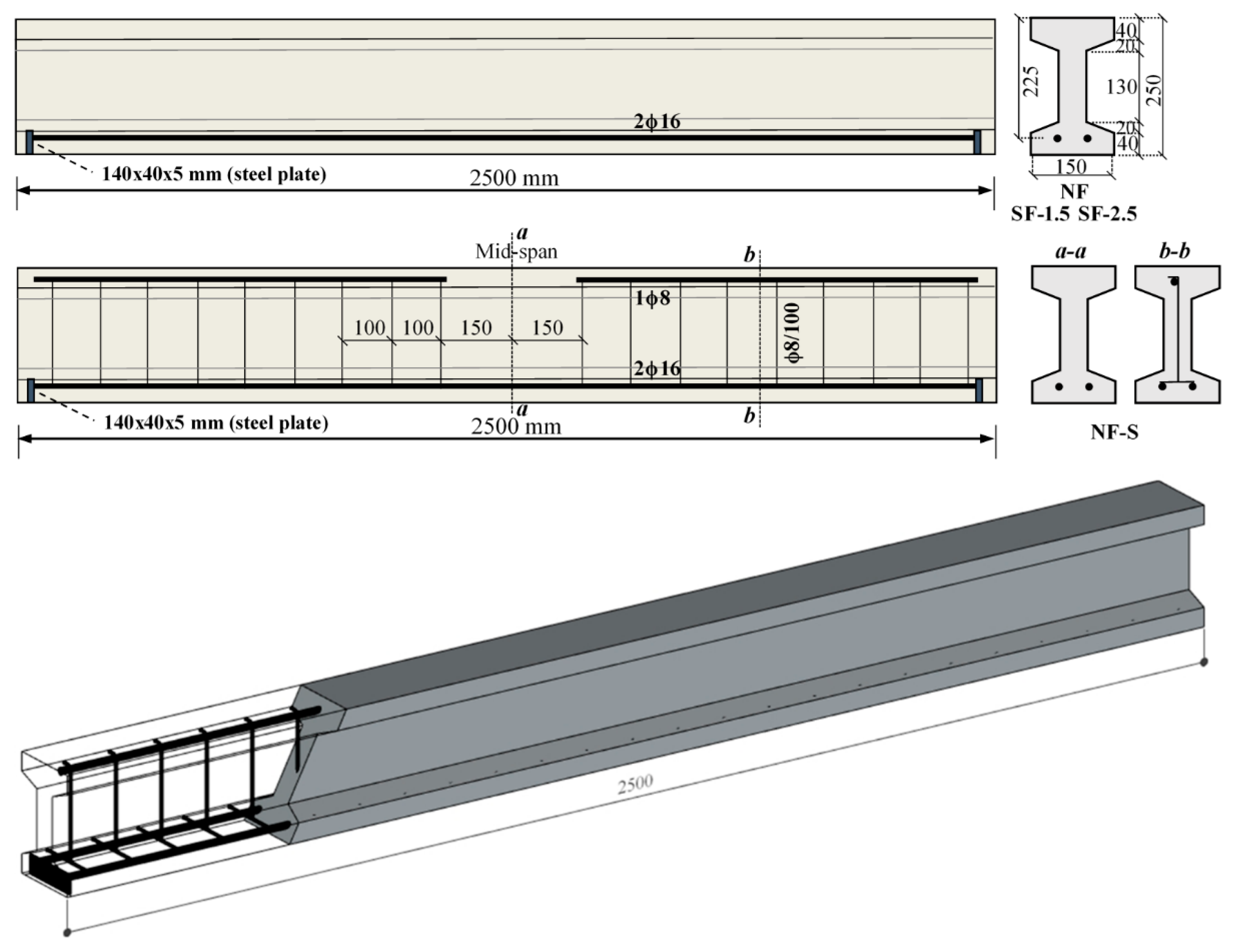
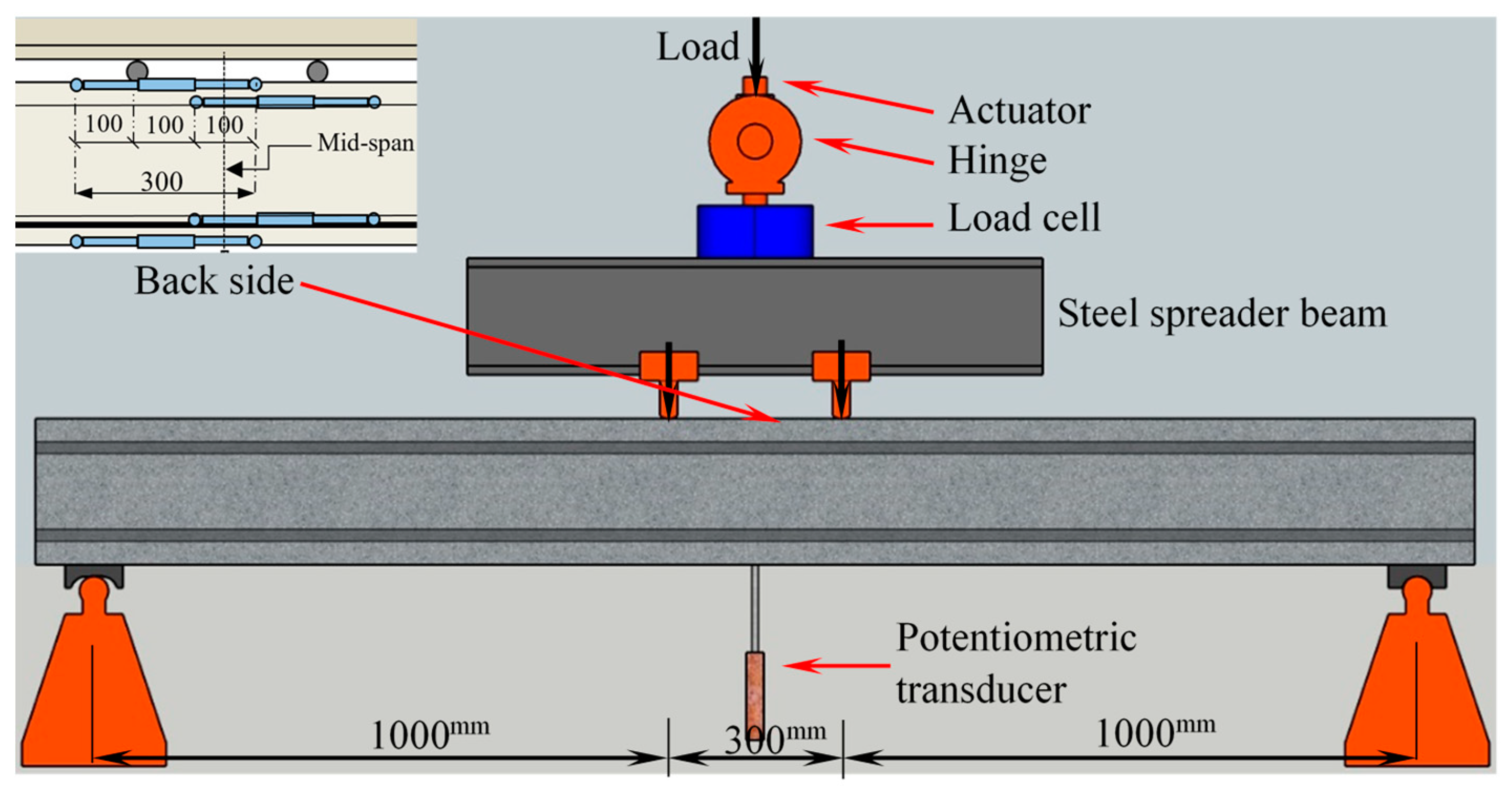
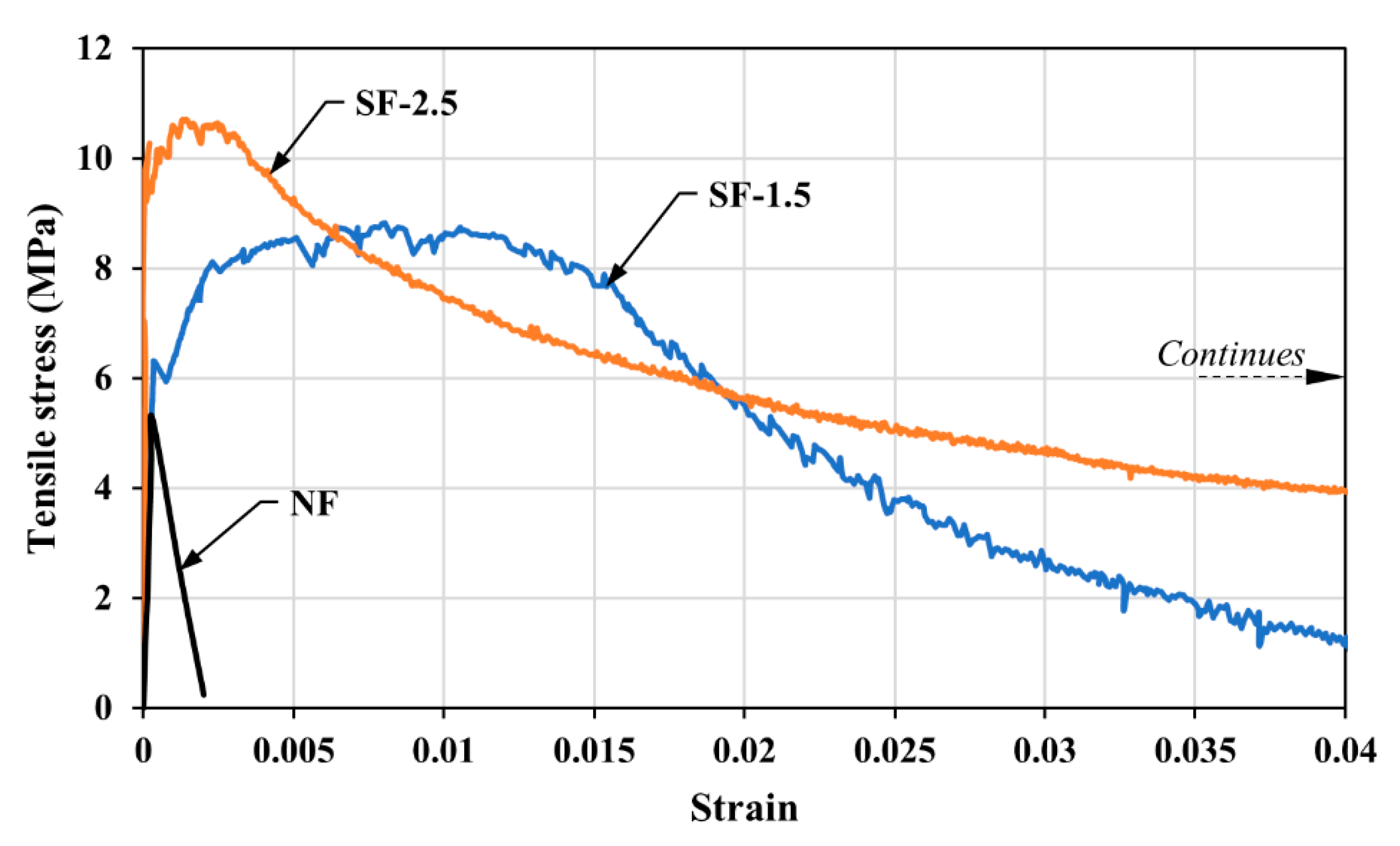

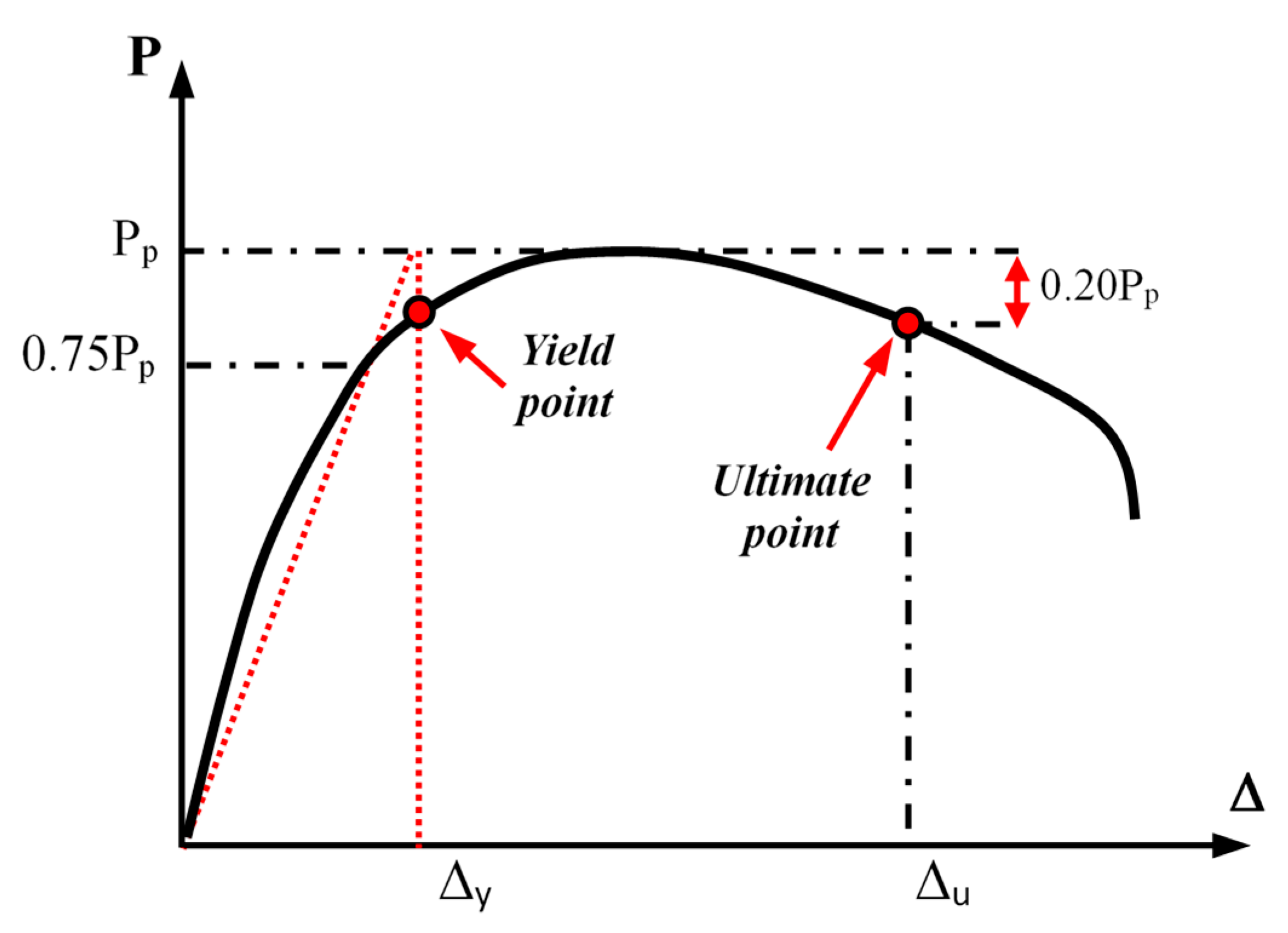
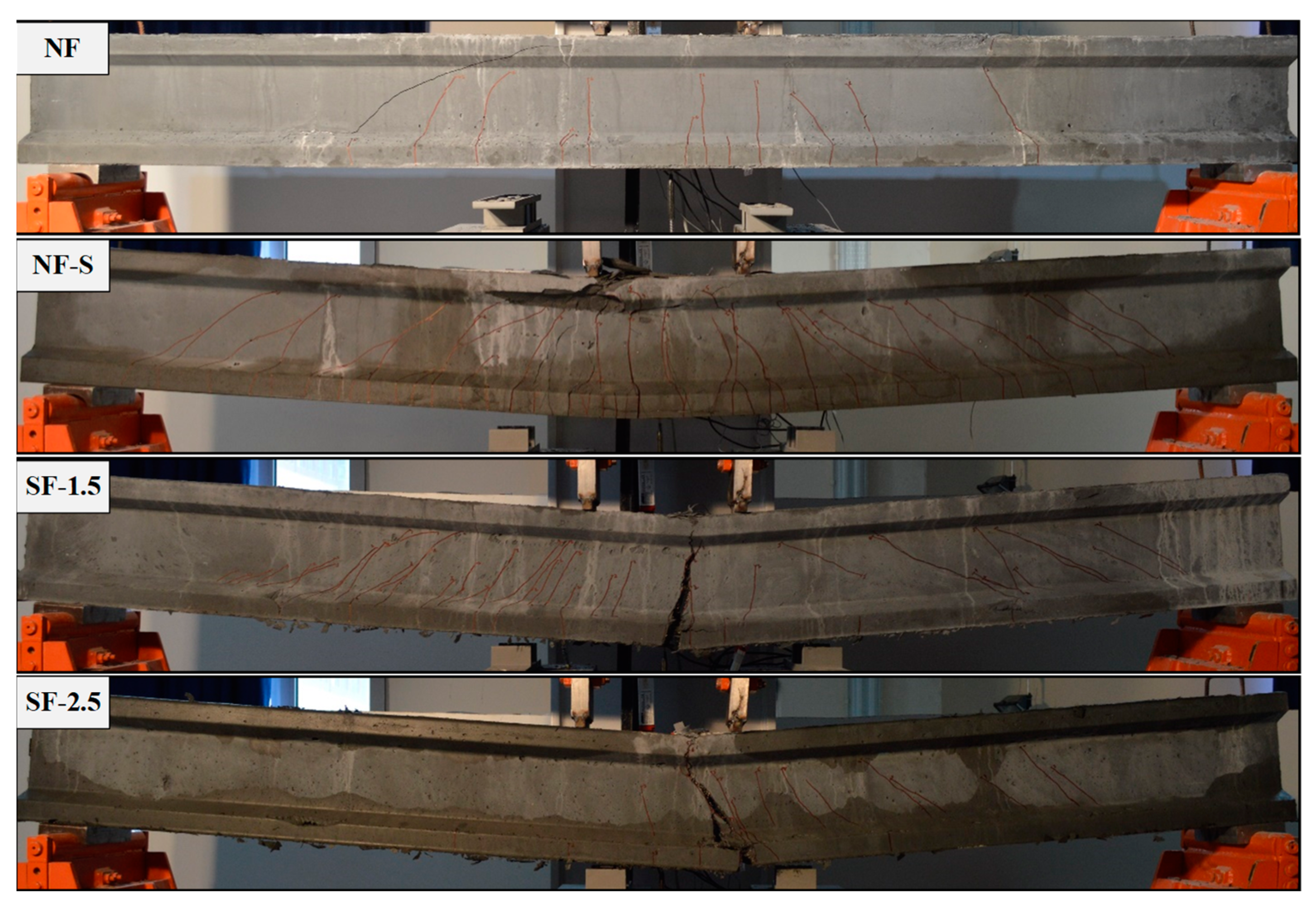
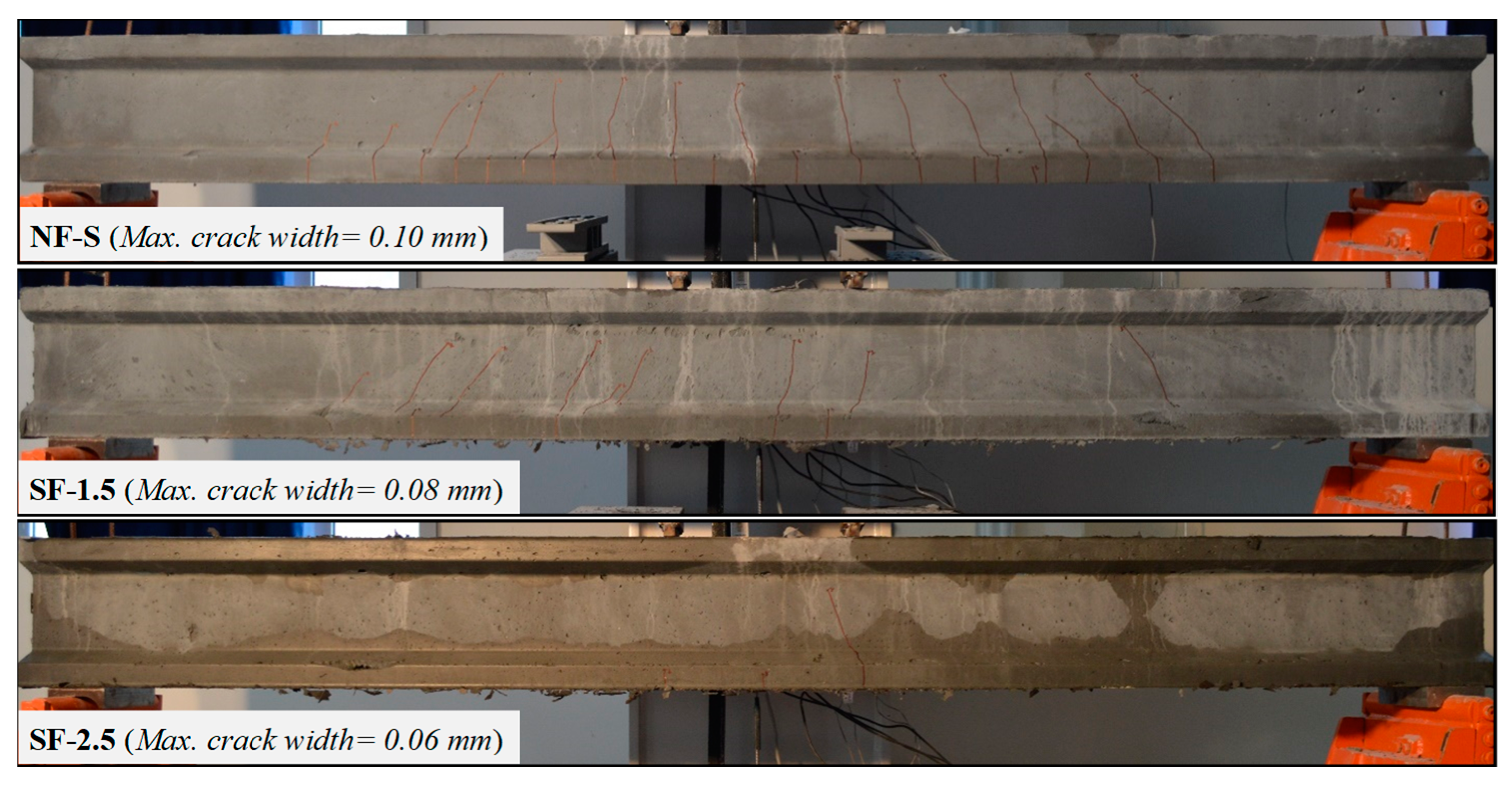
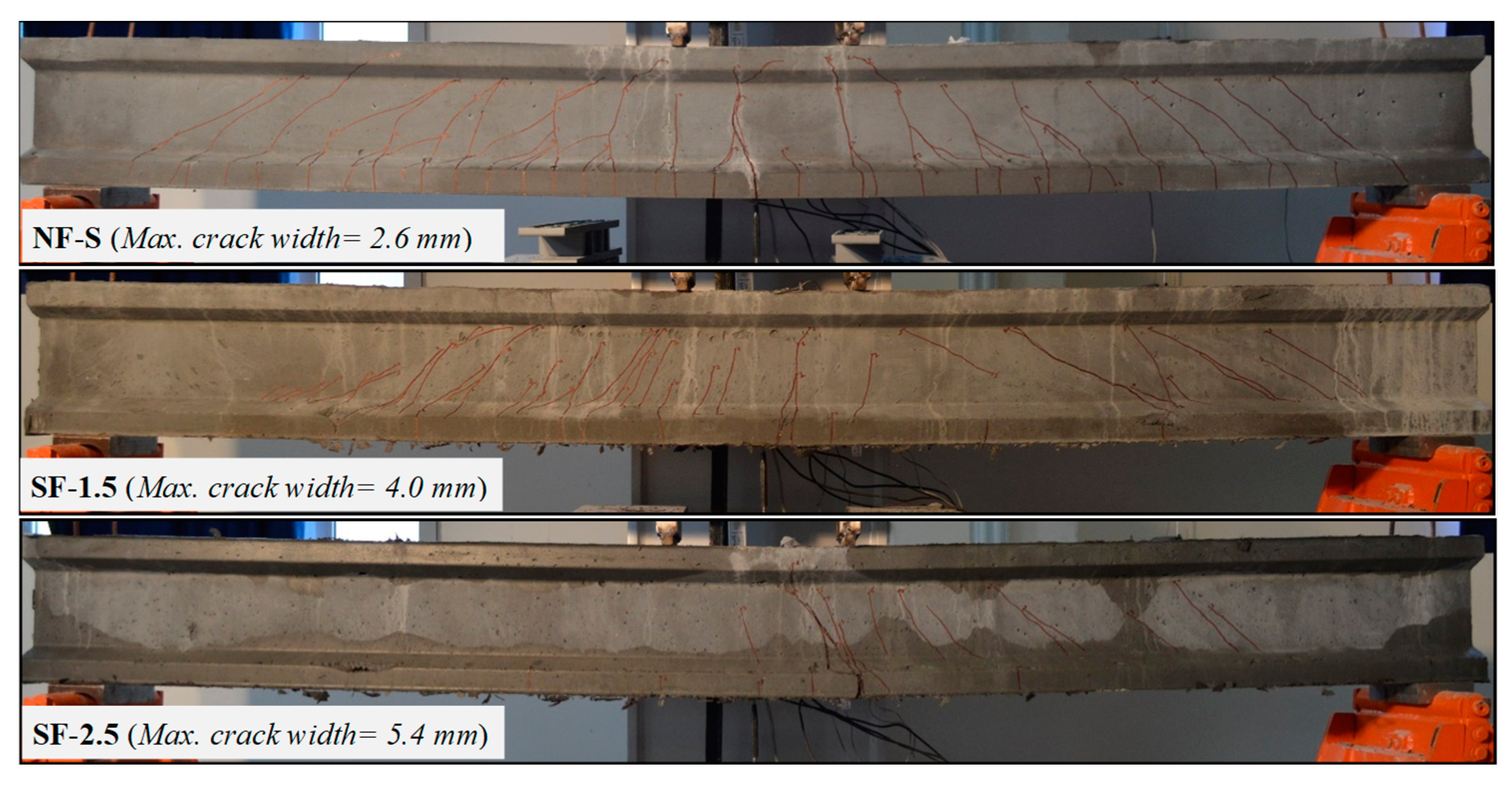
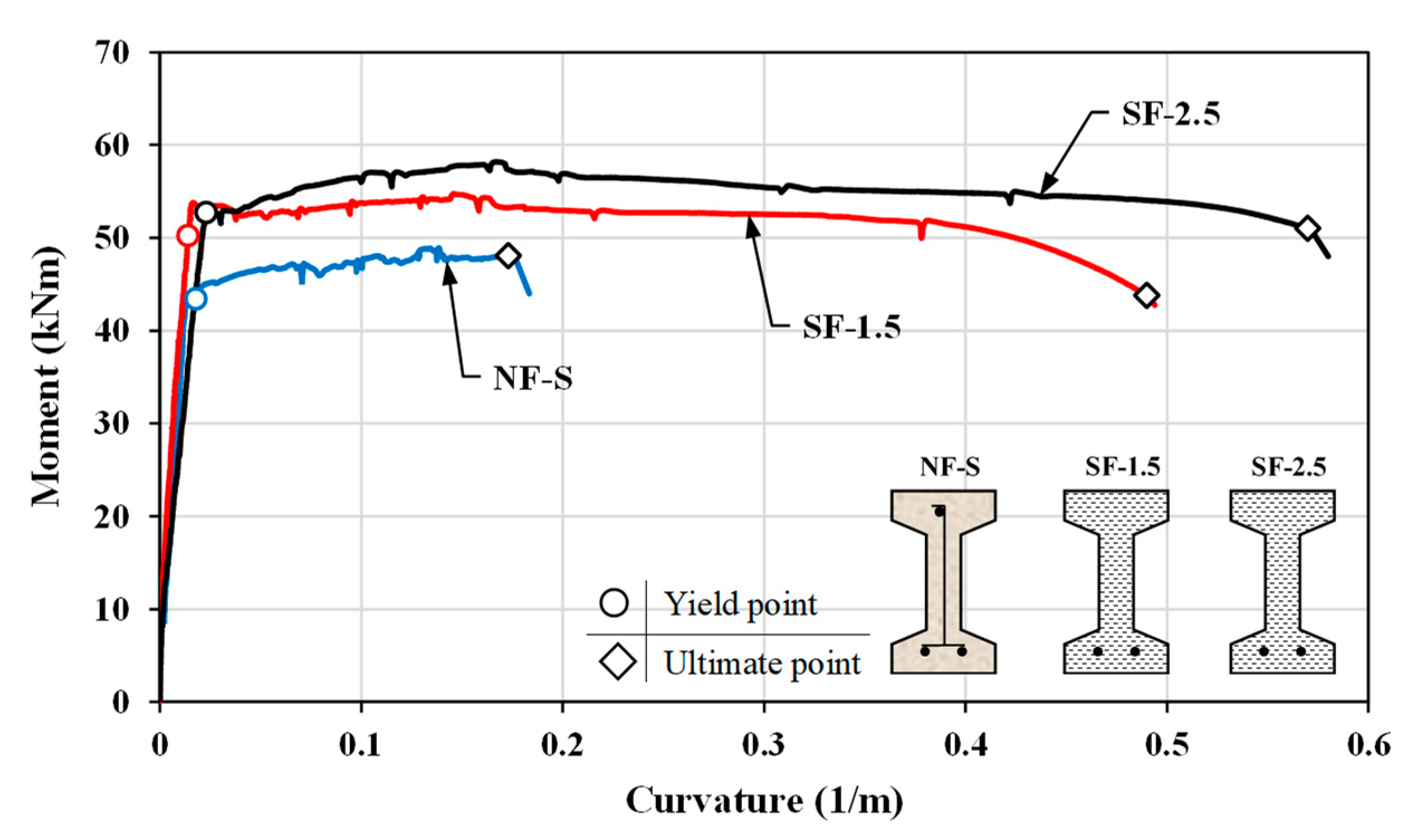
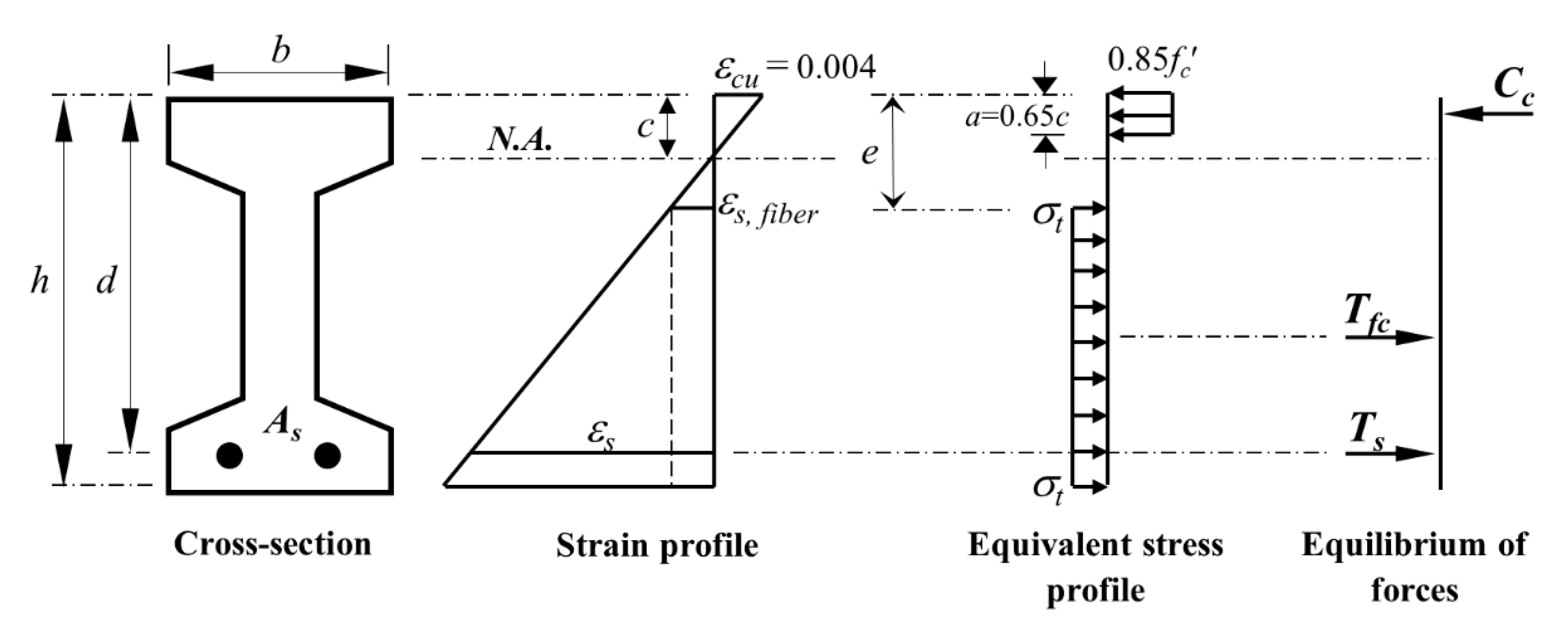
| Beam Name | Vf (%) | C | SF | GGBS | QS | W | SP |
|---|---|---|---|---|---|---|---|
| (kg/m3) | |||||||
| NF and NF-S | 0.0 | 720 | 240 | 240 | 890 | 204 | 23.0 |
| SF-1.5 | 1.5 | 720 | 240 | 240 | 852 | 204 | 23.6 |
| SF-2.5 | 2.5 | 720 | 240 | 240 | 825 | 204 | 24.3 |
| Beam Name | Reinforcement | Concrete | ||||
|---|---|---|---|---|---|---|
| fy (MPa) | fu (MPa) | fc’ (MPa) | ft (MPa) | Slump Flow | ||
| Spread (mm) | t500 (s) | |||||
| NF | 469 | 590 | 145 | 5.3 | 780 | 2.0 |
| NF-S | 470 | 591 | 142 | 5.1 | ||
| SF-1.5 | 470 | 591 | 154 | 8.8 | 730 | 3.0 |
| SF-2.5 | 473 | 593 | 159 | 10.7 | 700 | 3.0 |
| Beam Name | Yield Deflection Δy (mm) | Peak Load Pp (kN) | Ultimate Deflection Δu (mm) | Ultimate Load Pu (kN) | Deflection Ductility μΔ = Δu/Δy | Failure Mode/Reason |
|---|---|---|---|---|---|---|
| NF | - | 37.82 | - | - | - | Shear/diagonal tension |
| NF-S | 14.11 | 97.81 | 58.73 | 96.18 | 4.16 | Flexure/concrete crushing |
| SF-1.5 | 12.09 | 109.53 | 78.02 | 87.63 | 6.45 | Flexure/reinforcement rupture |
| SF-2.5 | 11.20 | 116.40 | 83.89 | 102.01 | 7.49 | Flexure/reinforcement rupture |
| Beam Name | Yield Curvature ϕy (1/m) | Peak Moment Mp (kNm) | Ultimate Curvature ϕu(1/m) | Ultimate Moment Mu (kNm) | Curvature Ductility μϕ = ϕu/ϕy | Effective Stiffness EIe = Mp/ϕy (kNm2) |
|---|---|---|---|---|---|---|
| NF | NA | 18.9 | NA | NA | NA | NA |
| NF-S | 0.018 | 48.9 | 0.17 | 48.1 | 9.4 | 2715 |
| SF-1.5 | 0.014 | 54.8 | 0.49 | 43.8 | 35.0 | 3899 |
| SF-2.5 | 0.023 | 58.2 | 0.57 | 51.0 | 24.8 | 2510 |
| Design Code | Vnexp (kN) | Vncal (kN) | Vncal/Vnexp |
|---|---|---|---|
| ACI 318 [36] | 18.91 | 20.31 | 1.07 |
| Eurocode 2 [39] | 18.91 | 26.88 | 1.42 |
| NZS 3101 [41] | 18.91 | 20.44 | 1.08 |
| Beam Name | Mpexp (kNm) | Mpcal (kNm) | Mpcal/Mpexp |
|---|---|---|---|
| NF-S | 48.9 | 41.5 | 0.85 |
| SF-1.5 | 54.8 | 58.3 | 1.06 |
| SF-2.5 | 58.2 | 62.2 | 1.07 |
© 2019 by the authors. Licensee MDPI, Basel, Switzerland. This article is an open access article distributed under the terms and conditions of the Creative Commons Attribution (CC BY) license (http://creativecommons.org/licenses/by/4.0/).
Share and Cite
Hasgul, U.; Yavas, A.; Birol, T.; Turker, K. Steel Fiber Use as Shear Reinforcement on I-Shaped UHP-FRC Beams. Appl. Sci. 2019, 9, 5526. https://doi.org/10.3390/app9245526
Hasgul U, Yavas A, Birol T, Turker K. Steel Fiber Use as Shear Reinforcement on I-Shaped UHP-FRC Beams. Applied Sciences. 2019; 9(24):5526. https://doi.org/10.3390/app9245526
Chicago/Turabian StyleHasgul, Umut, Altug Yavas, Tamer Birol, and Kaan Turker. 2019. "Steel Fiber Use as Shear Reinforcement on I-Shaped UHP-FRC Beams" Applied Sciences 9, no. 24: 5526. https://doi.org/10.3390/app9245526
APA StyleHasgul, U., Yavas, A., Birol, T., & Turker, K. (2019). Steel Fiber Use as Shear Reinforcement on I-Shaped UHP-FRC Beams. Applied Sciences, 9(24), 5526. https://doi.org/10.3390/app9245526





